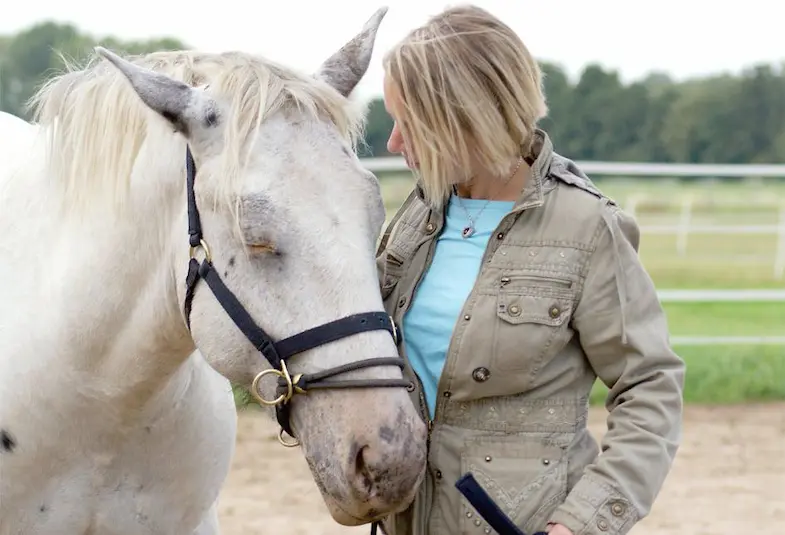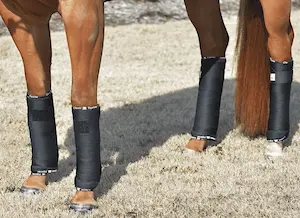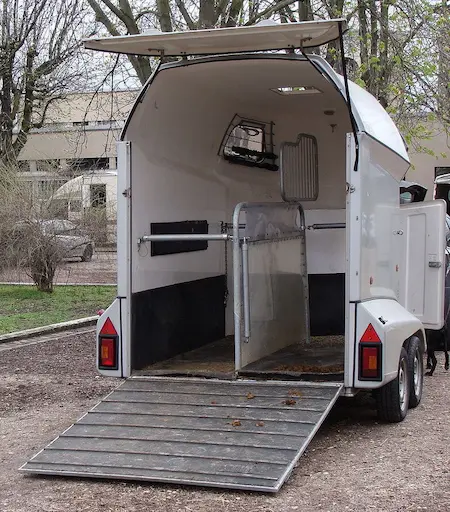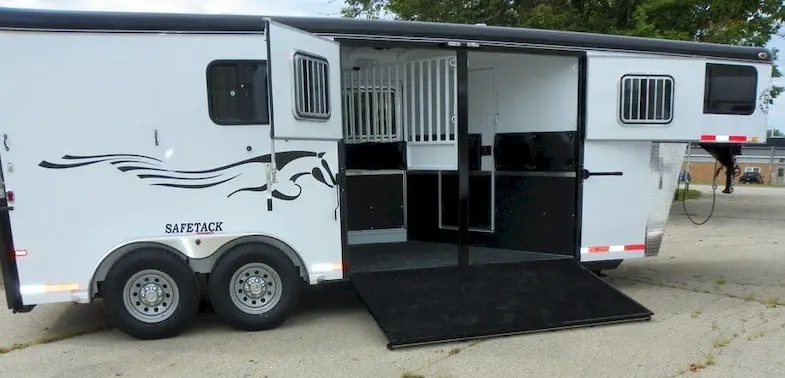If you’re lucky enough to have your own horse then chances are at some point you’ve had to transport them, whether for a show or a trip to the vet, and unless your horse is one of those miracle horses that don’t mind dark confined spaces you know loading a horse isn’t always plane sailing.
Teaching your horse to load
If your horse has never been loaded before then he’ll understandably be nervous so it’s important to take your time and get him used to the trailer before you start trying to load him. Some horses will happily walk into a trailer the first time you ask them to but most of them won’t so don’t expect him to do so straightaway and be patient, after all, how would you feel if somebody forced you into a dark room and you had no idea what was in the room? Instead, it’s important to take your time, have small goals, and reward your horse every time he does what you ask of him. NEVER tell him off for doing it wrong, this will only reinforce his fear. It’s important to not rush your horse, take your time and do a little bit each day, it might seem like it’s taking forever but in the long run, it’s far better for successful loading.
Don’t try and load your horse immediately, he needs to be comfortable around the trailer to start with, instead walk him past the trailer so that he doesn’t automatically think about it as something to dread. Do this for a few days then when he’s happy, walk him to the side of the trailer (if it’s a slant loader or the end if it’s a straight loader) and then give him a treat. This will help him to realize that a trailer isn’t anything to be scared of.
When your horse is happy standing by the trailer you can then think about leaving him near it for a short period of time. Hang a small haynet or leave a bit of hay on the floor then tie your horse to the trailer and walk away, allow your horse to still see you out of his peripheral vision though. Once your horse is happy with this you can open the doors of the trailer and then repeat the process.
After your horse is no longer worried about the trailer itself you can start to encourage him to step inside. This stage is the most crucial part of teaching your horse to load and absolutely shouldn’t be rushed at all. Begin by getting him to place just one foot on the ramp, allow him to stay there for a moment before rewarding him, and then leading him away. Each time you do this you should only ask your horse to take an extra step or two depending on how nervous he is. If, however, he starts to back away reassure him that it’s okay and when he’s ready walk him onto the ramp again, don’t allow him to completely back away as this will only reinforce his belief that there is something to be frightened of.
When your horse is happy walking up the ramp you can start to walk him inside although it’s important that you have all of the doors open so that it’s much lighter and he can see clearly. Start by asking him to only place his front feet inside before rewarding him and then leading him away from the trailer. Again you should take this step slowly but the ultimate goal is for your horse to willingly allow you to lead him into the trailer.
Once your horse is loading without any issues you can then begin shutting the doors, again though do this slowly and one door at a time. If you’re likely to only be transporting one horse then you might want to think about placing a safety mirror in the trailer, your horse will then think that there’s another horse in the trailer with him, this will, in turn, reassure him that it’s safe.
Do I need to use a pressure halter?
A pressure halter (or Dually halter) has a ring on its noseband that applies pressure to the upper part of the horse’s nose when he tries to back away from you. As soon as he moves towards you again the pressure is released, gently encouraging him to work with you rather than against you.
If it’s used in the right way it can be a humane way of training a horse to load, but like any training device, it has to be used in the right way. It should never be used as a substitute for good training but only as an aid. If you do decide to use one though you should get your horse used to how it works first, this can be done in the stall. When using the halter though it’s important to slacken the rope as soon as he works with you.
Whether or not use choose to use one is down to personal preference but, if used correctly, they can be a great training tool. That said though, every horse is different and, while they will work with most horses, they won’t work with every horse so if you don’t feel it’s working stop using it straight away.
Do I need to use travel bandages?
Whether you use travel boots or bandages, tail guards or tail bandages is up to you but you should always use some sort of protection on your horse while transporting him. This is not only for the horse’s safety but also to help keep them comfortable during loading and unloading but also while traveling. If you prefer to use bandages but aren’t sure how to use them this article I wrote will help (I know it’s on exercise bandages but the principle is the same).
Dos and don’ts for successful loading
DO be patient – the more you rush the longer it’ll take.
DO reward your horse when he does what you ask – positive reinforcement works far better.
DO stay calm and pay attention to your breathing – your horse will be looking to you to gauge if it’s safe if you’re showing signs of being nervous he’ll be nervous too.
DON’T tell your horse off when he gets it wrong – this will only confirm to him that there is something to be scared of.
DON’T load your horse into (or leave him in) an unhitched trailer – trailers are unstable and can tip up if they’re not hitched.
DON’T tie your horse inside a trailer before closing the partition or attaching the butt bar/chain (Most straight loading trailers have a butt bar or chain that your horse can rest against instead of resting on the rear door) – if he panics and tries to back out he could do himself some serious damage but the partition or bar will prevent him from backing out.
Quick tips for loading a difficult horse
If your horse is nervous or difficult to load don’t worry, with a little bit of time and patience you can re-train your horse and have him happily walk into the trailer. The method for doing this is pretty much the same as it would be for teaching him how to load in the first place but rather than just going over the same steps as before I’ll give a quick list to recap what you need to do.
- Take your time and be patient with your horse
- Stay calm, horses are sensitive animals and if you’re nervous your horse will pick up on this which will most likely confirm to him that there is something to be frightened of
- Don’t force him to do something he’s not happy with and NEVER tell him off for getting it wrong
- Walk him up to the trailer, praise him then walk him away again
- Repeat this until he’s happy and does this without any resistance or sign of anxiety
- Encourage him to put a stand on the ramp, don’t force him to put all his legs on it at first if he’s not happy
- When he’s happy standing on the ramp open the doors of the trailer and walk him inside, again praise him then take him away from the trailer
- Once you’ve done this a few times your horse should be much happier being loaded
- Next time you need to transport your horse loading him will be much easier (and quicker)
How to load (and unload) a horse in a straight loader
Before you load your horse make sure that all of the doors of the trailer are open, this will not only make the trailer seem brighter and less scary to your horse but it’ll also help you get out after you’ve successfully loaded him. Some people don’t like to load a horse on their own into a straight loader but if you’ve trained your horse to use a trailer you won’t have any problems.
You might not think that it matters which side the horse is on but if you’re only transporting one horse then he should always go on the same side as the driver, so if you drive on the right the horse (and driver) should be on the left and vice versa if you drive on the left. The same is true if you’re transporting two horses and one is much heavier, this is because of the camber of the road, but it also helps with balance as you go round corners.
When all of the doors are open slowly walk your horse up the ramp and into the trailer and secure the butt bar or chain (personally I prefer to attach a pad to the bar but the is up to you). Next, close the rear door/ramp and then go round to the front and tie your horse up. Your horse is now ready to go.
As you might expect, to unload your horse, you follow the loading instructions in reverse order. Some people like to open the rear door before untying their horse but I personally like to untie him first of all, that way if something spooks him and he decides to rush out as soon as you open the rear door he’s less likely to hurt himself. Make sure you keep reassuring your horse all the while you’re walking around the trailer and unloading him.
How to load (and unload) a horse in a slant loader
While they do tend to be more expensive, a lot of people prefer slant loaders because they can just turn the horse around when unloading rather than backing the horse out. Research carried out by the famous horse whisperer, Monty Roberts, has also shown that horses prefer slant loaders because standing across the trailer while moving allows them to balance themselves better.
The principles behind loading a horse into a trailer from the side are more or less the same as it is for loading them into the rear of the trailer. To start with you should make sure that all of the doors and partitions are open. I appreciate that not everybody has the time to spend training their horse to stand still without being tied up but if you do then you can just leave your horse in the trailer while you walk around to close the partition behind him. If, however, your horse won’t stand without being tied up then you can use an open window, or the slats on a stock style (A livestock trailer suitable for transporting horses with open slats instead of windows)) trailer to feed the lead rope out of to help keep your horse in place until you’ve closed the partition and tied him up. It’s important to NEVER tie your horse up with the partition open, this is because if he pulls back he can cause himself some serious harm. With the partition closed, however, he’s not able to pull back. Once you’ve done this you can then safely tie your horse inside the trailer.
One of the advantages of a slant loader comes when it’s time to unload your horse, rather than untying them and then walking backward out of the trailer you can simply turn your horse around and walk him out of the trailer.
How to keep your horse calm in the trailer
Once you’ve successfully loaded your horse into the trailer you’ll still need to make sure he’s calm and not stressed while transporting him. If you’re planning to travel a long way then it’s important to schedule regular stops along the way, this will give your horse time to not only stretch his legs but will also reassure him that he’s not stuck in the trailer. Some people like to use calming supplements or tablets to help keep their horse relaxed during travel, personally though, I don’t like to use these but that doesn’t mean to say they don’t have their benefits. There are a number of different things that you can do though to help keep your horse calm during the journey.
- Make sure there’s plenty of hay and water – The horse’s digestion is only able to digest small amounts of food at a time so they need to have a regular supply of food and water. If your horse doesn’t have this then he is likely to become stressed, being able to eat will also keep your horse occupied and therefore automatically reduce his stress levels.
- Drive carefully – While you can’t account for other drivers on the road you can drive carefully and anticipate possible hazards. Don’t brake or accelerate suddenly and make sure you’re smooth around corners. This might sound obvious but I’ve sadly seen one too many accidents to know that not everybody drives carefully when transporting horses.
- If your horse is traveling alone install a safety mirror – Horses don’t like to be alone but if you have a safety mirror where they can see it they’ll think there’s another horse with them. Instead of recognizing himself in the mirror he’ll think it’s another horse and will naturally be more relaxed thinking there are other horses around.
- Use lavender oil or a lavender spray – We’ve all heard how relaxing and de-stressing lavender can be to use but it’s just the same with horses. The best thing is that its the smell of the lavender that works so it doesn’t matter whether it’s dried, a spray or lavender oil that you’ve rubbed into your horse’s coat, they all work just as well.
- Play some gentle music – Some horses respond well to gentle music being played while they’re in transit. You can start by playing something quietly to your horse while you’re grooming him and if he responds well to it you can then play it while transporting him.
- Use wall-mountable toys – Something such as a Bizzy Bite (available on Amazon) can be fixed inside the trailer and will give your horse something to play with and chew while being transported.
- Make sure your horse is comfortable – It might sound obvious but make sure your horse has enough space to move and that he’s suitably rugged if the weather’s cold, and consider opening a window (if you have one) if the weather’s hot.
- Keep idle time to a minimum – While there may be times when you have to leave your horse in a stationary trailer try to keep this to a minimum. Even if you unload him and tie him up outside its better than leaving him inside.
Further reading
Now that you’ve trained your horse to load and unload properly you can travel to shows, for vacations, or even abroad. If you are thinking about traveling abroad with your horse, you may find this article interesting.
I hope you found this article helpful. If you did I’d be grateful if you could share it please as it would really help me.
Recommended products
Over the years I have tried hundreds of different horsey products, from various blankets and halters to different treats. Some I’ve loved, others I’ve hated but I thought I’d share with you my top all-time favorite products, the ones I never leave the yard without. I’ve included links to the products (which are in no particular order) that I really think are great.
- Horse Knots by Reference Ready – If you’re like me and enjoy pocket reference guides then you’ll love this knot tying guide. These handy cards can easily fit in your pocket or attach to the saddle for quick reference. They’re waterproof, durable and are color coded to make them easy to follow.
- Mane ’n Tail Detangler – Even if you never show your horse you’ll need to detangle his tail from time to time (and possibly his mane too) which is always a challenging chore! I’ve found that if I run a little bit of detangler through my horse’s tails every few days it stops them from getting matted up and makes combing them easy, even if they’re coated in mud. I don’t know if I should admit to this or not but it also works wonders on my hair.
- TAKEKIT Pro clippers – Over the years I’ve tried a lot of different clippers and while some were obviously better than others I found these to be by far the best. They are heavier than a lot of other clippers but for me, that’s a good thing, it makes them feel more sturdy and hardwearing. On top of that they have a range of speeds so are just as good for clipping your horse’s back as they are his face. I also like the fact that they come in a handy carry case but that’s not for everybody. The company that makes them is super good and incredibly helpful too, a real bonus these days. The only thing I wasn’t keen on was the fact that it doesn’t come with any oil, but that’s not a major problem as it’s not difficult to buy lubricant.
- Shire’s ball feeder – There are so many boredom buster toys out there but I like to use these every day, regardless of whether or not my horses are bored. I find that it helps to encourage my horses to problem solve by rewarding them with treats (or pieces of fruit) but it also mimics their natural grazing behavior which helps to keep them calm and de-stressed.
- Horse safe mirror – This is a strange one that many people are surprised about but I like to put horse safe mirrors in the trailers as well as in the quarantine stalls. It helps to prevent the feeling of isolation by giving the impression of other horses being around. Being herd animals horses can get extremely stressed when they feel that they’re on their own but with these stick-on mirrors, they believe that at least one other horse is with them.
- Rectal thermometer – I know this isn’t glamourous at all but it’s vital for your horse’s well-being to be able to check their temperature and a rectal thermometer is the easiest way of doing this which is why I’ve added it to the list.
Shopping lists
I’ve also put together a few shopping lists of essential items that I’ve found helpful over the years. I’ve broken the lists down into different categories rather than put everything in one massive list 😉





